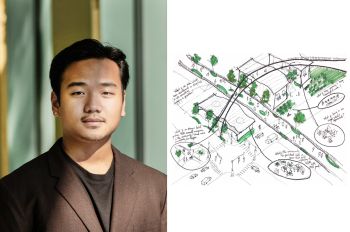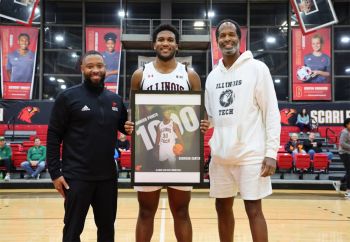Showing How ‘You Can Do Just About Anything’ With a Math Degree

Victoria Belotti (AMAT/STATS, M.S. CDSO ’22) often is asked, “What are you going to do with a math degree?” Her answer is, “You can do just about anything.”
Mathematics is at the heart of analyzing data in the sciences, tech, finance and banking, and even government. Belotti will be using her mathematical skills as a data analyst with Capital One to begin her career.
“I am looking forward to continuing my professional development in Capital One’s Analyst Development Program,” she says. “In general, I am interested in working in fields within or adjacent to data science and analytics, or operations research.”
She landed the job as a direct result of a summer internship with Capital One. She worked on a credit modeling project for 10 weeks with a team of other interns and professionals at Capital One. Belotti was asked to use the company’s credit data to make predictions related to issuing credit line increases, how cardholders will make payments, and why cardholders use their Capital One card rather than a competitor’s.
“From a technical standpoint, I was ready for the work,” Belotti says. “There were some specifics that I had to learn. I had never worked with credit data, and I had to get caught up on some of the terminology that’s used in the industry.”
Belotti discovered that communicating with corporate leaders is a lot different than communicating with professors. Her professors want to see the details of the work that she performed. Corporate leaders, on the other hand, are more interested in the bigger picture.
“They want you to get to the results—to the bottom line,” she says. “I was confident as a writer going into the internship, but found out that when you present to business leaders, they want to see concise slides.”
She also learned a lot about how the corporate environment works.
“Maybe the culture is company-specific, but I found the environment to be a lot more laid back than school,” she says. “There’s no homework. The clock ends, and the work is done.”
Belotti also used her statistics skills in the climate study field through the National Science Foundation’s Research Experience for Undergraduates at the University of North Carolina at Greensboro. She participated in a topological data analysis project with other undergraduates, Ph.D. students, postdocs, and professors who were studying gas bubbles in polar ice sheets.
The goal was to estimate the number of bubble microstructures from X-ray images of ice cores at different depths in the ice sheets. These pores trap gasses from the atmosphere, preserving important records as to how the Earth’s climate has changed over time. Climatologists want to get as much information as possible about where these bubbles are located in the ice sheets before they open the sheets to collect the data within these bubbles.
“I knew nothing about topology,” Belotti says. “But I did know enough about statistics to do the work.”
She estimated how many bubbles were located in a specific area of the ice sheet, and how big those bubbles might be. The team published a research paper based on their work, entitled “Topological Estimation of 2D Image Data Via Subsampling and Application to Firn” in IEEE Access, a journal published by the Institute of Electrical and Electronics Engineers, with Belotti as the lead author.
“I was really excited to write the paper, but it was also really stressful,” she says. “It’s tough knowing what to include, and the acceptance process was stressful, too. There was a lot of back and forth in the editing process.”
Although working in business and climatology environments were new to Belotti, she says that she was well prepared to do the work within those areas thanks to the knowledge that she acquired through her coursework. In some cases, she was better prepared than other interns thanks to prior experience with coding languages such as Python and SQL.
Although she has used her knowledge of mathematics and data analytics in the business and climatology fields, Belotti says there are other fields that she thinks she can apply these skills over the course of her career.
“The operations research side of me also thinks it would be really cool and interesting to work in the field of transportation engineering and design, particularly for designing new public transit networks and expanding current ones throughout the United States,” she says. “Another interesting field I might consider is supply chain logistics, which, as we have seen over the last two years, is vital to the global economy.”
Photo: Victoria Belotti (AMAT/STATS, M.S. CDSO ’22)




